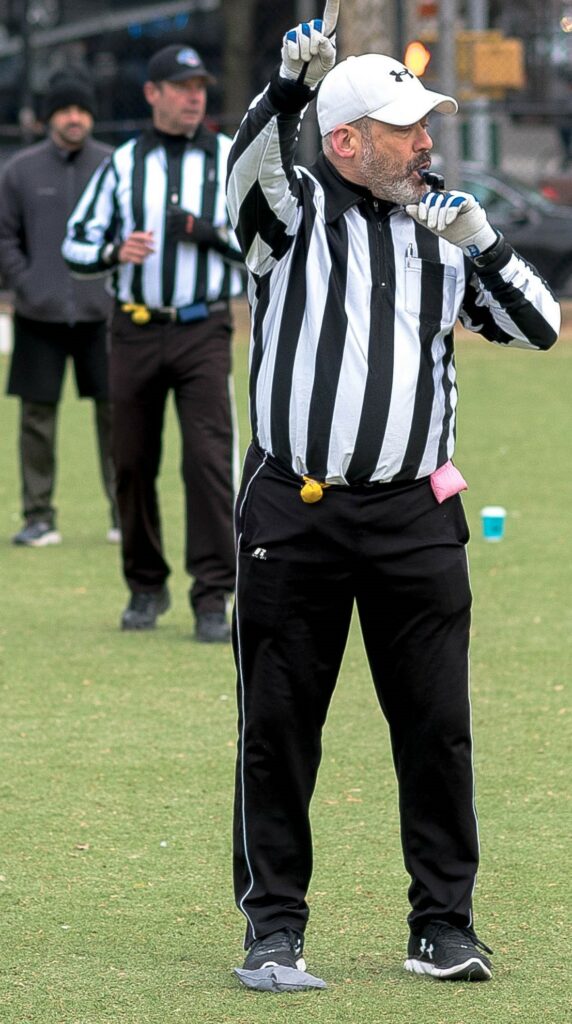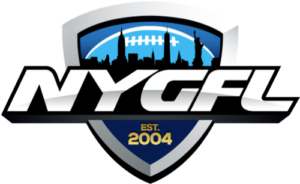Rules of Play
Rules of Play
Whether you are a seasoned veteran, rookie player, or someone who is considering joining the league, the documents below serve as both a high level overview and complete guide of the NYGFL Rules of Play.
Each game is played in 25-minute halves with a 5 minute break at halftime (unless otherwise agreed to by opposing captains). The game clock runs continuously until the final 2 minutes of each half, unless stopped by a timeout. In the last 2 minutes, the clock will stop for player timeouts, official timeouts for penalty enforcement or injury, first downs, a runner going out of bounds, incomplete passes, and scores. The clock begins on the ready-for-play whistle if it had been stopped for a first down or official timeout. The clock begins on the next snap after a team timeout, a runner going out of bounds, an incomplete pass, or a score.
There is a 25-second play clock between plays. Each team gets 2 timeouts per half.
- A first down is awarded after ten yards, unless modified by penalties.
- There are no fumbles – the ball is dead when it touches the ground.
- The ball must be on the ground for a snap.
- Only one running play per offensive drive.
- The QB is considered to be across the line of scrimmage (and therefore cannot make a legal forward pass) if any body part is across the line.
- Every offensive player must be set for one full second before the snap. After being set, a player is allowed to go in motion. If multiple players are in motion, every player needs to re-set.
- Only one player may be in motion parallel to the line of scrimmage at the time of the snap.
- There is no penalty for intentional grounding by the QB.
- No flag guarding is allowed, including stiff-arming, lowering your head or shoulder when running with the ball, running with your hands below your waist, or jumping to avoid being de-flagged. Spinning is allowed.
- No charging into an opponent – a ball carrier must go around a stationary player.
- Teammates cannot push or pull a runner with the ball.
- A receiver needs to get one foot in bounds with possession of the ball for a legal catch.
- Downfield blocking is allowed after a receiver makes a catch or a runner has crossed the line of scrimmage. Regular blocking rules (described below) apply.
- The first rusher to cross the line of scrimmage must start from 5 yards behind the line of scrimmage. After this player has crossed the line of scrimmage, any other defender/rusher can cross the line of scrimmage from any distance. Rush restrictions end once a QB passes the football.
- A pass rusher must avoid charging into a blocker. When encountering a blocker, a pass rusher must (a) stop prior to making contact with the blocker or (b) clearly change direction in an effort to move around the blocker.
- If a pass rusher makes an effort to move around the blocker and the blocker moves into the path of the pass rusher, there is no penalty for charging.
- “Tackling” – Only way to “tackle” a ball-carrier is to remove their flag. A defender can’t push the player out of bounds or try to knock them down. A defender is not allowed to obstruct the forward progress of a ball-carrier.
- Defenders are allowed to contact receivers within 5 yards of the line of scrimmage. Blocking rules apply here as well. Defenders cannot have contact with the receiver (other than incidental) beyond 5 yards. When defending a pass, defenders must make a play on the ball only.
- For announced punts all teammates of the kicker must be within 1 yard of the line of scrimmage and can cross the line of scrimmage once the ball is kicked. Teams have the option to quick-kick on any down.
- For announced punts, the receiving team must have 4 players within 10 yards beyond the line of scrimmage until after the ball is kicked
- Touchdowns are 6 points.
- Following a touchdown, an extra point can be made by converting a play from the 5 yard line or 2 extra points by converting from the 10 yard line. Running is allowed on all extra point tries.
- A team may only change its decision on a 1-or 2-point try after using a team timeout.
- If a team intercepts a pass or fumble during the try and returns it for a touchdown, the team scores 2 points.
- During an extra point try, if the defense commits a foul and the conversion attempt is unsuccessful, then the offense can attempt to try for 2 points from the 5 yard line or try for 1 point from the 2.5 yard line.If the conversion attempt is successful, the offense can either decline the penalty or attempt to try for 2 points from the 5 yard line.
- During a two-point conversion try, if the defense commits a foul and the conversion attempt is unsuccessful, then the offense can attempt to try for 2 points from the 5 yard line.
- Mercy Rule: The game will end if one team is winning by 25 points at the 5-minute mark or 17 points at the 2-minute mark or under
- A player will be penalized for participating in a down without a flag belt. If a player’s belt falls off during a play, a 1-hand touch is required to end the down.
- Towels may be worn by the center only and must not interfere with the positioning of their flags. The towel is considered an extra flag on the belt and can be pulled to de-flag the player.
- Baseball caps must be worn backwards. Exposed jewelry is not allowed, with the exception of stud earrings which may be worn by a player at his/her own risk. Hanging or loop earrings are not allowed, nor is any other exposed jewelry that is not covered by the jersey or shorts/pants. Necklaces may only be worn if they remain under the shirt or are taped down.
- No bracelets or loose bands around the wrist may be worn unless covered by a tight-fitting sweatband.
- An errant snap that touches the ground is spotted at the previous spot and the down counts. In essence, it is treated as an incomplete pass.
- A fumbled ball is dead once the ball touches the ground. If the ball is fumbled backwards, it is spotted where the ball touches the ground. If the ball is fumbled forward, it is spotted where the ball carrier lost possession. An incomplete backwards pass is treated as a fumble and spotted where the ball touches the ground.
Unsportsmanlike conduct includes:
- Abusive, insulting, baiting or taunting language or gestures
- Unnecessary roughness or overly physical conduct during or following a down
- Spiking the ball or throwing the ball from the field of play
- Insubordination towards a referee
- Any other conduct deemed unsportsmanlike, dangerous, or unbecoming as determined by any referee of a given game
Any player committing an act that the referee deems flagrant and semi-violent will be assigned a personal foul and will be automatically ejected for 4 scrimmage plays. The player’s team will also receive a 10 yard penalty.
Any player who accrues 2 or more personal fouls in a game will be suspended automatically for the remainder of that game and potentially for the subsequent game, subject to review by the NYGFL Board.
Violent personal fouls (such as throwing a punch) will result in automatic ejection for the remainder of the game and will be reported to the NYGFL Board for investigation and potentially further action.
The NYGFL Board reserves the right to review personal fouls and determine whether the severity of the foul and/or number of accumulated fouls merits disciplinary actions in addition to or separate from those listed above, including, but not limited to, partial or full suspension from future games, a full-season suspension, or a review of the player’s standing in the league.
- The NYGFL Board will make any decision on game postponements or cancellations before the first games of the day when possible. Once games begin, head referees will be responsible for the pausing or cancellation of games.
- In line with the NCAA's lightning safety policy and National Lightning Safety Institute, gameplay will be stopped if lightning is within 6 miles of the fields. If thunder is heard less than 30 seconds before a flash, it is likely that the lightning is within 6 miles.
- When instructed by referees, all individuals must leave the playing field and seek a safe location.
- Games can resume 30 minutes after the last flash of lightning within 6 miles.
- In the case of standing water (or ice) on the fields, head referees will confer to determine if the fields are safe to play.

